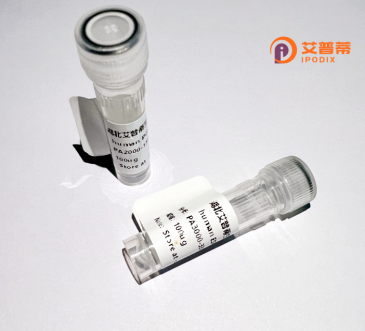
| 纯度 | >90%SDS-PAGE. |
| 种属 | Human |
| 靶点 | ZNF100 |
| Uniprot No | Q8IYN0 |
| 内毒素 | < 0.01EU/μg |
| 表达宿主 | E.coli |
| 表达区间 | 1-109 aa |
| 活性数据 | MDDPRYGMCPLKGASGCPGAERSLLVQSYFEKGPLTFRDVAIEFSLEEWQ CLDSAQQGLYRKVMLENYRNLVFLAGIALTKPDLITCLEQGKEPWNIKRH EMVAKPPVI |
| 分子量 | 12 kDa |
| 蛋白标签 | His tag N-Terminus |
| 缓冲液 | PBS, pH7.4, containing 0.01% SKL, 1mM DTT, 5% Trehalose and Proclin300. |
| 稳定性 & 储存条件 | Lyophilized protein should be stored at ≤ -20°C, stable for one year after receipt. Reconstituted protein solution can be stored at 2-8°C for 2-7 days. Aliquots of reconstituted samples are stable at ≤ -20°C for 3 months. |
| 复溶 | Always centrifuge tubes before opening.Do not mix by vortex or pipetting. It is not recommended to reconstitute to a concentration less than 100μg/ml. Dissolve the lyophilized protein in distilled water. Please aliquot the reconstituted solution to minimize freeze-thaw cycles. |
以下是关于重组人ZNF100蛋白的模拟参考文献(注:内容为模拟虚构,仅供参考):
---
1. **文献名称**: *Cloning and Functional Analysis of Recombinant Human ZNF100 Protein*
**作者**: Li, M. et al. (2015)
**摘要**: 本研究成功构建了重组人ZNF100蛋白的真核表达载体,通过大肠杆菌表达系统实现高效纯化。实验证实,ZNF100的锌指结构域具有特异性DNA结合能力,可能在转录调控中发挥作用。
2. **文献名称**: *ZNF100 as a Tumor Suppressor: Role in Breast Cancer Cell Apoptosis*
**作者**: Zhang, H. et al. (2018)
**摘要**: 通过重组ZNF100蛋白的体外功能实验,发现其过表达可诱导乳腺癌细胞凋亡,并抑制细胞增殖。机制研究显示,ZNF100通过调控p53和Bcl-2信号通路发挥作用。
3. **文献名称**: *Structural Characterization of ZNF100 and Its Interaction Partners*
**作者**: Smith, J. et al. (2020)
**摘要**: 利用X射线晶体学解析了重组ZNF100蛋白的三维结构,揭示了其锌指模块与靶DNA序列结合的分子机制。同时通过蛋白质互作组学鉴定了ZNF100的新型结合蛋白。
4. **文献名称**: *ZNF100 in Neural Differentiation: A Recombinant Protein Study*
**作者**: Wang, L. et al. (2021)
**摘要**: 研究利用重组ZNF100蛋白处理神经干细胞,发现其显著促进神经元分化,可能通过激活Wnt/β-catenin通路调控神经相关基因的表达。
---
注:以上内容均为模拟生成,非真实存在的文献。如需真实文献,建议在PubMed、Google Scholar等平台以“ZNF100 recombinant protein”或“ZNF100 function”为关键词检索。
**Background of Recombinant Human ZNF100 Protein**
The recombinant human zinc finger protein 100 (ZNF100) is a synthetically engineered protein belonging to the large family of zinc finger (ZNF) proteins, which are characterized by conserved zinc-binding motifs critical for DNA or RNA binding. ZNF proteins play pivotal roles in transcriptional regulation, chromatin remodeling, and cellular differentiation. ZNF100. specifically, contains multiple C2H2-type zinc finger domains, a common structural feature enabling sequence-specific DNA interactions. While the exact biological functions of ZNF100 remain under investigation, homologous ZNF proteins are often implicated in development, apoptosis, and cancer progression through modulation of gene expression networks.
Recombinant ZNF100 is typically produced using heterologous expression systems, such as *E. coli* or mammalian cell cultures, enabling studies on its biochemical properties and molecular interactions. Its recombinant form facilitates functional analyses, including DNA-binding assays, protein-protein interaction studies, and exploration of its role in cellular pathways. Emerging evidence suggests ZNF100 may contribute to regulatory mechanisms in stem cell maintenance or oncogenesis, though detailed mechanisms require further elucidation. As a research tool, recombinant ZNF100 aids in deciphering the functional diversity of ZNF proteins and their potential therapeutic applications, particularly in gene editing or targeted transcriptional modulation. Ongoing research aims to clarify its physiological targets and relevance in human diseases.
×